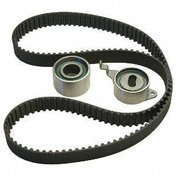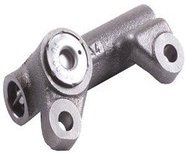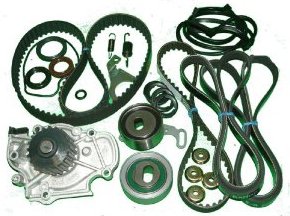About Timing Belts

People often ask me about timing belts. Sometimes the question is when or how to replace a timing belt. On Foreign cars your better off getting a service kit (available below). Other times they might be having a performance problem and deep down inside they believe that the belt may have something to do with it.
All automotive manufacturers have recommended maintenance guidelines for this wearable component. Nothing that is made out of rubber will last forever. With the improved technologies used in the manufacturing process cars today enjoy longer life then vehicles just a few years ago. But they will still need to be serviced.
For example when I worked for Mazda many of their engines had timing belts. The manufacturer’s guidelines for replacement in the 90s were every 70,000 miles. Very few customers followed those guidelines. They either didn’t know the part needed to be replaced or ignored the factory’s recommendations.
In these cases we would most often see the vehicle on the flatbed. What was interesting about it was how long the car would actually go past the recommended interval. On Some cars the belt failed at 71,000 miles. On other cars they went as far as 125,000 miles before the belt broke and the car had to be towed.
More about timing belts

The valve train and the camshaft work together to open and close the intake and exhaust valves of the engine. The camshaft is rotated from the mechanical force from the crankshaft. It is the job of the timing belt to keep this relationship on track.
As a timing belt ages some slack can and will develop. This is why many engines with a chain driven camshaft and all engines with a belt driven camshaft use some kind of tensioner. Some of these are simple and use a spring type that operate in the same way as a serpentine tensioner. Some are much more complicated and use a hydraulic type tensioner.
Even the mighty timing chain can stretch a little and most manufacturers use a spring-loaded nylon shoe to maintain the proper tension on the chain itself. Sometimes these nylon shoes are referred to as timing chain guides. In my opinion a chain driven camshaft is more reliable and will require less service if any.
Replacing timing belts

I have replaced many in my 26 year auto repair career. The procedures for each vehicle are so different that I always break out a service manual and follow the factory’s guidelines for replacement. The timing belts on a Honda Civic often drive the water pump. In this case you might as well replace the water pump at the same time.
On a Toyota you made need a tensioner compressor. In the case of a Mazda protégé replacing the timing belt is extremely easy and I can do it in about an hour and a half. The hardest timing belt I ever replaced was a complicated set up on a 3.4 L dual overhead cam Chevy Lumina LTZ. That one took me about two days.
So even though people ask me all the time how long is it going to take me to replace the timing belt on my car, unless I have done it several times I really don’t have an answer for them. But I can tell them this, you should stick to the maintenance guidelines that the factory recommends no matter how hard the job is.
Some engines are known as free spin motors and when the belt breaks no damage occurs. Other engines are called interference engines and when the belt breaks it can bend the valves and damage pistons. Be on the safe side and replace the timing belt at the mileage recommended.
For more information on common car repairs you can visit the homepage for this auto repair information blog. If you want to see how to find service procedures for your specific vehicle you can visit my other site and watch the video about my recommended online auto repair manuals.

